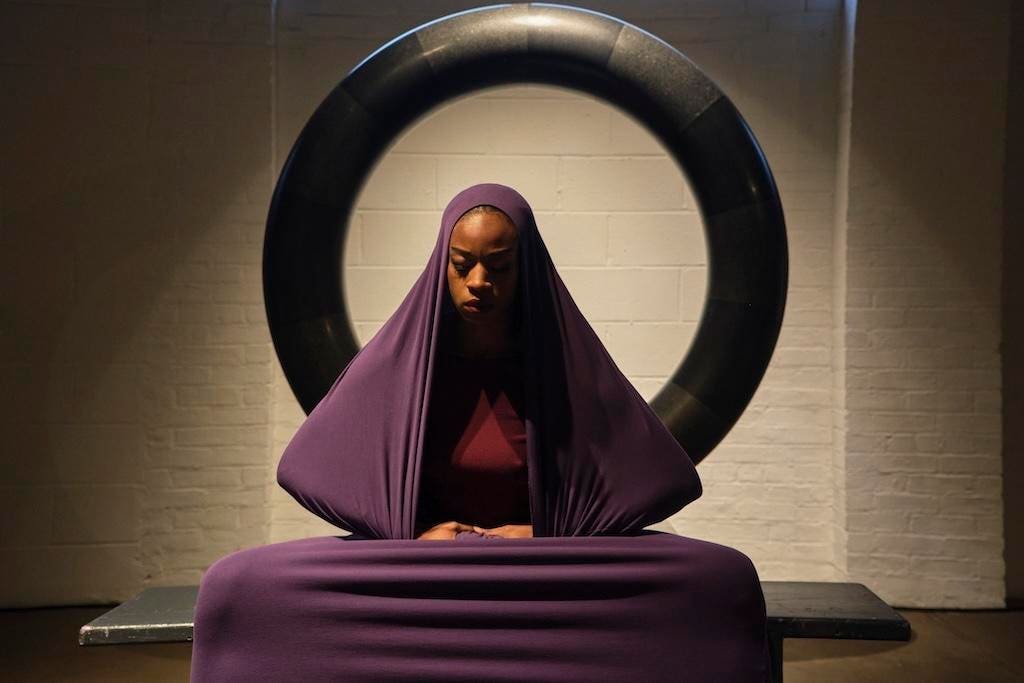Leslie Andrea Williams, principal dancer with Martha Graham Dance Company, performs Lamentation … More
Photo: Don Stahl. © The Isamu Noguchi Foundation and Garden Museum, NY / ARS
Enveloped in a plum-colored tube-like garment from which only her head, hands, and feet peek out, Leslie Andrea Williams is framed by a black granite circular sculpture evoking the passage of day and night, light and darkness, symbolizing the origin of life.
Williams, principal dancer with Martha Graham Dance Company, gently shifts her head from left to right. She tilts and twists her upper body, swaying rhythmically. The angular motions of her torso, head, and arms simultaneously juxtapose with and align with Isamu Noguchi’s Sun at Midnight (1973).
As Williams’ movements intensify, the plum costume transforms into geometric shapes such as squares, triangles, and rhomboids, while she maintains a solemn gaze. She grasps the upper edge of her costume with a hoisted fist, flexing it over her head. Williams lowers her head as she sits in a meditative pose. Her fluid movements and expressions convey profound sorrow of catharsis.
Williams’ ethereal performance last Friday of Lamentation (1930), a modern dance solo choreographed by legendary American modern dancer, teacher and choreographer Martha Graham (1894-1991) to Piano Piece, Op. 3, No. 2 by Hungarian composer, ethnomusicologist, music pedagogue, linguist, and philosopher Zoltán Kodály (1882-1967), ignited the The Noguchi Museum.
“What an honor to perform Lamentation here 🥲 I’ve dreamt of performing here since I first came to visit during my first year in the company 10 years ago,” Williams, who describes herself as a “creative storyteller” across artistic genres, wrote on her Instagram. “It was so special to be amongst the set pieces made for Martha while also becoming a ‘sculpture come to life.’✨ Thank you to the Noguchi Museum team for a wonderful evening.”
Play Puzzles & Games on Forbes
Leslie Andrea Williams, principal dancer with Martha Graham Dance Company, performs Lamentation … More
Photo © Hisae Aihara / © The Isamu Noguchi Foundation and Garden Museum, NY / ARS
Williams’ nearly-four-minute performance in AREA 3 on the first floor of the expansive museum in Queens, New York, was among four pop-up solos throughout the museum by Martha Graham Dance Company, with choreography and costumes by Graham, Artistic Director Janet Eilber, and Executive Director LaRue Allen. New York-based Martha Graham Dance Company is the nation’s oldest professional school of dance, and the only one primarily focused on the Martha Graham Technique.
Leslie Andrea Williams, principal dancer with Martha Graham Dance Company, performs Lamentation … More
Photo © Hisae Aihara / © The Isamu Noguchi Foundation and Garden Museum, NY / ARS
Guests wandered through the massive space, a creative, contemplative oasis tucked into the mixed industrial and residential area in Astoria, Queens, watching the dancers interact with the sculpture, as they enjoyed a selection of exquisite Japanese dishes by chef, restaurateur, and creative director Kiyo Shinoki, along with specialty cocktails provided by Suntory.
Chef Kiyo Shinoki. Noguchi at Night, May 9, 2025, The Noguchi Museum, New York.
Photo © Hisae Aihara / © The Isamu Noguchi Foundation and Garden Museum, NY / ARS
Noguchi at Night, a one-night dance and culinary experience, also included pop-up performances of Ekstasis (1933), Satyric Festival Song (1932), and Spectre-1914 (1936), amplifying the collaborative legacy of Graham and Noguchi. Proceeds from Noguchi at Night benefitted The Isamu Noguchi Foundation and Garden Museum.
Much like the divorce of sciences and arts, there is too much under-utilized fungible space between the visual arts and the performing arts. Masters of their own art forms, Graham and Noguchi recognized that they were stronger together and that drawing together dance and sculpture magnifies the appreciation and human connection that nourishes humanity.
Groundbreaking at every turn, Noguchi (1904-1988) founded The Isamu Noguchi Garden Museum (now The Noguchi Museum) in 1985, as the first museum in the United States to be established, designed, and installed by a living artist to show their own work. His ethos and spirit pulsates throughout the idyllic interior and garden galleries, whisking New Yorkers and visitors away from the frenzy of daily routine, reminding us that art is essential, not extraneous, to our existence and fortitude. The breadth and scope of Noguchi’s oeuvre is as stupendous as the space he created to make it accessible to future generations. An easy 18-minute walk from the N/W trains, the museum presents an inimitable transmuting and regenerative immersive experience.
My son Michael Alexander and I were grateful for the tip to stop by the impeccably curated Noguchi Museum Shop to purchase traditional incense from Kungyokudo, Japan’s oldest incense house. Riemon Ouno opened Kungyokudo in 1594, across from the Hongwanji Temple in Kyoto to provide incense and medicine to the monks of the Jodo Shinshu Hongwanji-ha Buddhist school. Kungyokudo is now owned and operated by Ouno’s 22nd-generation descendant, Kazuo Ouno, and his wife, Chihaya Ouno.

